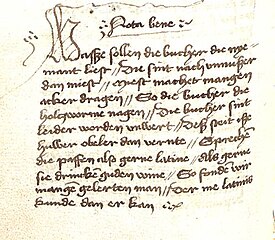Nota bene (/ˈnoʊtə ˈbɛneɪ/, /ˈnoʊtə ˈbɛni/ or /ˈnoʊtə ˈbiːni/; plural: notate bene) is the Latin phrase meaning note well.[1] In manuscripts, nota bene is abbreviated in upper-case as NB and N.B., and in lower-case as n.b. and nb; the editorial usages of nota bene and notate bene first appeared in the English style of writing around the year 1711.[2][3][4] In Modern English, since the 14th century, the editorial usage of NB is common to the legal style of writing of documents to direct the reader's attention to a thematically relevant aspect of the subject that qualifies the matter being litigated,[5] whereas in academic writing, the editorial abbreviation n.b. is a casual synonym for footnote.


In medieval manuscripts, the editorial marks used to draw the reader's attention to a supporting text also are called nota bene marks; however, the catalogue of medieval editorial marks does not include the NB abbreviation. The medieval equivalents to the n.b.-mark are anagrams derived from the four letters of the Latin word nota, thus the abbreviation DM for dignum memoria ("worth remembering") and the typographic index symbol of the manicule (☞), the little hand that indicates the start of the relevant supporting text.[6]
See also
editReferences
edit- ^ "nota bene". Collins English Dictionary - Complete & Unabridged 11th Edition. CollinsDictionary.com. Retrieved 2012-10-22.
- ^ Addison, Joseph (1891). The Works of Joseph Addison. W. W. Gibbings. p. 283.
- ^ Addison, Joseph (2004). "No. 102 Wednesday, June 27, 1711". Project Gutenberg.
- ^ Harper, Douglas. "nota bene". Online Etymology Dictionary. Retrieved 2016-03-02.
- ^ "nota bene". HM Courts & Tribunals Service – Glossary of terms – Latin. Her Majesty's Courts Service, United Kingdom. Archived from the original on 2012-10-03. Retrieved 2012-09-28.
- ^ Raymond Clemens and Timothy Graham, Introduction to Manuscript Studies (Ithaca: Cornell University Press, 2007), p. 44.